In 1546 the Benedictine nuns of Le Murate in Florence celebrated the installation of Giorgio Vasari’s monumental painting of the Last Supper (measuring a total of 2.4 x 6.4 m) on the wall of their convent refectory. Three centuries later the convent was suppressed, the structure re-purposed as a prison and the five wooden panels comprising Vasari’s painting were relocated to the refectory of the Basilica of Santa Croce. There Vasari’s Last Supper joined Taddeo Gaddi’s 14th-century fresco of the same subject. Indeed the theme had become popular for the decoration of convent and monastery refectories as a means of inviting resident nuns or monks to partake in their communal meal in remembrance of Christ’s final meal with his apostles. Traditionally, these ‘Cenacoli’ were executed in fresco directly onto the wall, as in Gaddi’s example. Vasari’s more unusual wooden support may be explained by the original destination of the painting, a cloistered convent which could not house the artist for the six months it reportedly took to complete. By working on panel however, Vasari could paint in his studio and then transport and assemble the piece on site.
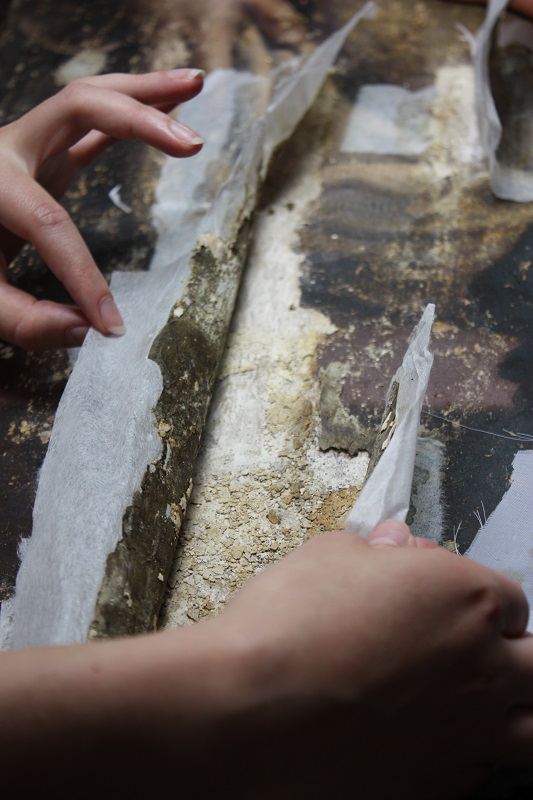
The painting’s gesso ground was washed away during the flood, forming pockets. Photo: Britta New
Unfortunately, both the relocation of the panels to Santa Croce and their wooden support made them especially vulnerable when the Arno flooded in 1966 and the refectory was submerged under five metres of a mixture of water, mud and heating oil. Both Vasari’s panels and Gaddi’s fresco, among many other works, were heavily damaged. Gaddi’s fresco however, was masterfully removed from the wall and restored to its present state following the flood while Vasari’s panels, which had been submerged for over 12 hours, were much more difficult to treat. The water had softened the paint layer and gesso and saturated the wooden support structure so that these no longer adhered one to the other and, in more extreme cases, parts of the paint and supporting gesso had slid down towards the bottom of the painting.
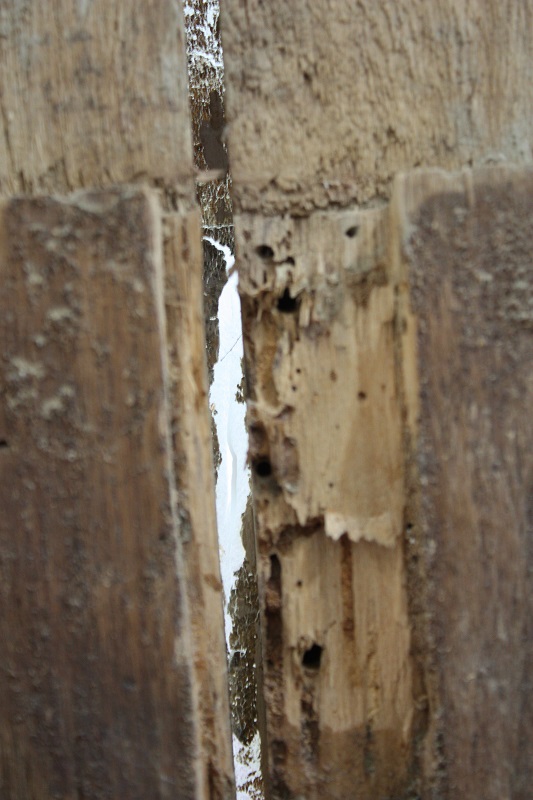
Open panel joins caused by the shrinkage of the wood, with the paint film still held in place above by the tissue facing. Photo: Britta New
The fragile painted surface was covered with sheets of tissue paper to prevent the paint from peeling and flaking off and the panels were relocated to the Limonaia of the Boboli Gardens, where over 200 panel paintings were treated in the flood’s aftermath. There the panels were laid out to dry slowly in a controlled environment in order to avoid warping and splitting. Despite close monitoring however, the wooden support of Vasari’s painting shrank during the drying process, causing the paint surface to lift off of the support. In the more extreme cases, the surface was held together only by the thin layers of paper that had been affixed to the front of the painting. For almost four decades, the extremely poor state of the work led conservators to consider it unsalvageable. It was only in 2004, when Vasari’s panels were moved to the Opificio delle Pietre Dure (OPD), Italy’s first modern restoration laboratory, that conservators began the slow, painstaking process of consolidating the flaking paint surface.
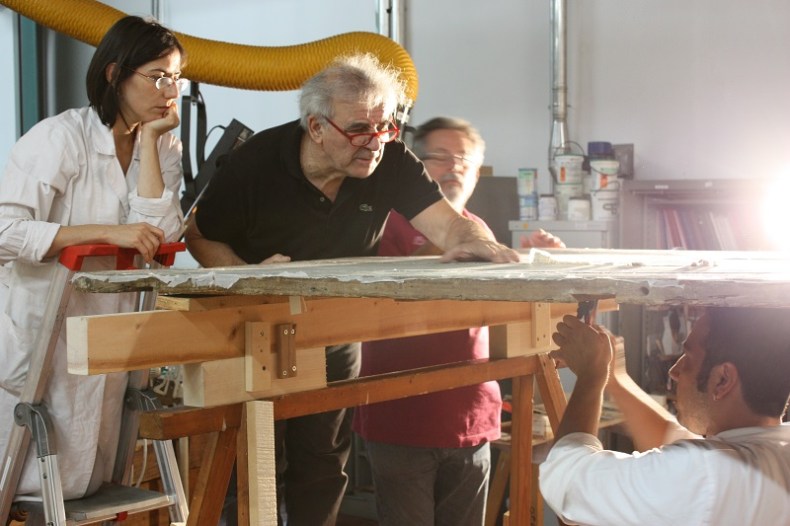
Debora Minotti, Ciro Castelli and Mauro Parri discuss the restoration work as Aldo Manzo makes adjustment to the position of one of the board joins. Undulations are visible on the surface of the painting. Photo: Britta New
It is estimated that around 14,000 works of art were damaged during the flood, not to mention 3 to 4 million books, manuscripts and archival documents, many of which were housed in the areas adjacent to the Arno such as the Biblioteca Nazionale Centrale di Firenze and the houses and churches in the area of Santa Croce. While many objects were damaged beyond repair, roughly two thirds of the salvageable artworks were repaired in the first 15 years following the flood, leaving around another 450 languishing untouched for lack of funds, skilled restorers and the technology to treat them.
In 2006, the 40th anniversary of the flood, 19 restored works – eight of which were masterpieces conserved by the OPD – were returned to Santa Croce and reinstalled in the Museum of the Opera di Santa Croce. Among these were Cimabue’s famous Crucifix (1287–88), which had lost up to 60 per cent of its painted surface, Agnolo Bronzino’s spectacular Descent of Christ into Limbo (1552) and Francesco Salviati’s Deposition (1547–48). The extremely damaged state of Vasari’s Last Supper however meant that little more than the consolidation of the paint surface was done until 2010, when the OPD, in collaboration with the Panel Paintings Initiative sponsored by the Getty Foundation, received a three-year grant for the work’s structural conservation.
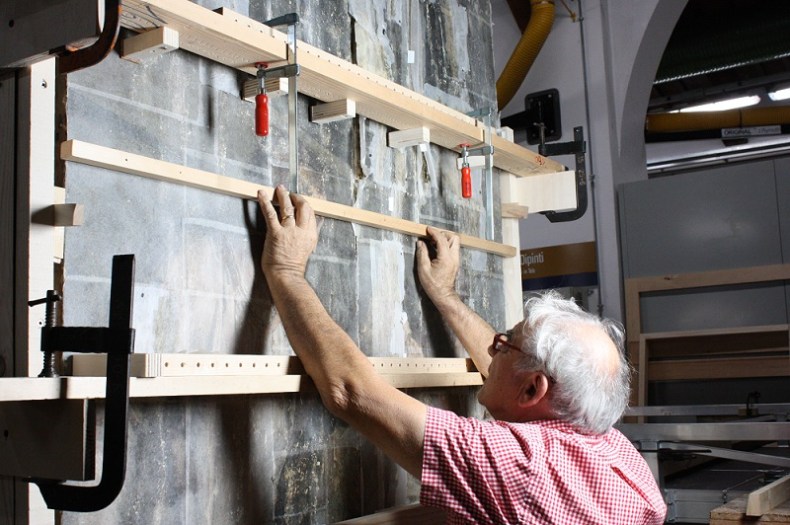
Ciro Castelli checking the surface of one of the panels during repair of the board joins. Photo: Britta New
Bringing together conservation specialists and students from Europe and Northern America, this initiative facilitated the sharing of experience and information on the newest techniques for resolving structural issues, and granted access to one of the most complex conservation projects ever undertaken. By 2013, the wood substrate of The Last Supper had been stabilised and its five panels were reconnected for the first time in 47 years. Additional funding from the Prada fashion house, in collaboration with the Fondo Ambiente Italiano, in 2014 allowed the OPD to begin the lengthy restoration of the missing areas of paint. A group of talented conservators, co-ordinated by the OPD’s deputy director of painting conservation, Cecilia Frosinini, began the task of retouching the paint surface long deemed beyond repair. The restored Last Supper was triumphantly re-installed in the refectory of Santa Croce on the 50th anniversary of the flood this November.
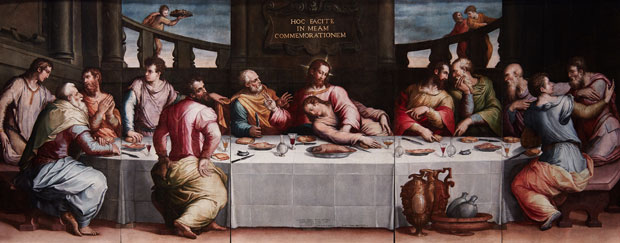
Last Supper (1546), Giorgio Vasari. Photo: ZEPstudio/Opera di Santa Croce
Despite these great developments, thousands of damaged works still require attention. The Biblioteca Nazionale, for example, has a storeroom full of books to be repaired and the Basilica di Santa Croce has at least 10 16th-century altarpieces in great need of attention. Further initiatives in private palaces and smaller museums are ongoing and are largely reliant on securing external funding. Ongoing concerns regarding the safety of vulnerable works in the case of another major flood have led to a number of significant changes over the last 50 years. Water management dams were constructed upstream in the 1980s and, in 2013, it was decided to transfer some of the recently restored altarpieces from the low-lying museum to a higher area of the complex. As an extra precaution, both Cimabue’s Crucifix and Vasari’s Last Supper have been installed on winches so that they can be hoisted upwards and out of harm’s way.
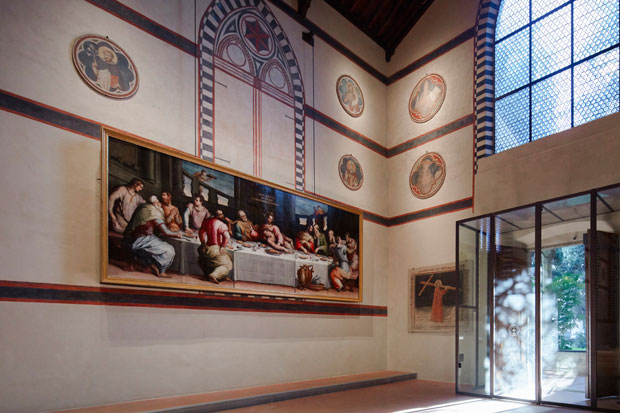
Giorgio Vasari’s Last Supper (1546) back on display in Santa Croce, Florence, 2016. Photo: ZEPstudio/OPera di Santa Croce
Beyond Florence, the collaboration with the Getty’s Panel Painting Initiative has given conservators such as Britta New at the National Gallery in London – a colleague of mine who advised on this article – the opportunity to work closely with leading structural panel experts and learn from their many years of experience. In our recent discussions, Britta told me ‘the time I spent working with conservators at the OPD during the Vasari project was invaluable and has enabled me to increase my “toolbox” for dealing with complex structural issues here in London.’ She also indicated that although the Vasari project was finished, it had ‘spurred an ongoing exchange of ideas and practices between a number of international professionals.’ Indeed the open dialogue and sharing of information between conservators precipitated by the Vasari project will undoubtedly continue to facilitate work in this area in the future.

The 50-year rescue of Vasari’s flood-damaged masterpiece
Giorgio Vasari's 'The Last Supper' was severely damaged during the Florence flood of 1966. Photo: Britta New
Share
In 1546 the Benedictine nuns of Le Murate in Florence celebrated the installation of Giorgio Vasari’s monumental painting of the Last Supper (measuring a total of 2.4 x 6.4 m) on the wall of their convent refectory. Three centuries later the convent was suppressed, the structure re-purposed as a prison and the five wooden panels comprising Vasari’s painting were relocated to the refectory of the Basilica of Santa Croce. There Vasari’s Last Supper joined Taddeo Gaddi’s 14th-century fresco of the same subject. Indeed the theme had become popular for the decoration of convent and monastery refectories as a means of inviting resident nuns or monks to partake in their communal meal in remembrance of Christ’s final meal with his apostles. Traditionally, these ‘Cenacoli’ were executed in fresco directly onto the wall, as in Gaddi’s example. Vasari’s more unusual wooden support may be explained by the original destination of the painting, a cloistered convent which could not house the artist for the six months it reportedly took to complete. By working on panel however, Vasari could paint in his studio and then transport and assemble the piece on site.
The painting’s gesso ground was washed away during the flood, forming pockets. Photo: Britta New
Unfortunately, both the relocation of the panels to Santa Croce and their wooden support made them especially vulnerable when the Arno flooded in 1966 and the refectory was submerged under five metres of a mixture of water, mud and heating oil. Both Vasari’s panels and Gaddi’s fresco, among many other works, were heavily damaged. Gaddi’s fresco however, was masterfully removed from the wall and restored to its present state following the flood while Vasari’s panels, which had been submerged for over 12 hours, were much more difficult to treat. The water had softened the paint layer and gesso and saturated the wooden support structure so that these no longer adhered one to the other and, in more extreme cases, parts of the paint and supporting gesso had slid down towards the bottom of the painting.
Open panel joins caused by the shrinkage of the wood, with the paint film still held in place above by the tissue facing. Photo: Britta New
The fragile painted surface was covered with sheets of tissue paper to prevent the paint from peeling and flaking off and the panels were relocated to the Limonaia of the Boboli Gardens, where over 200 panel paintings were treated in the flood’s aftermath. There the panels were laid out to dry slowly in a controlled environment in order to avoid warping and splitting. Despite close monitoring however, the wooden support of Vasari’s painting shrank during the drying process, causing the paint surface to lift off of the support. In the more extreme cases, the surface was held together only by the thin layers of paper that had been affixed to the front of the painting. For almost four decades, the extremely poor state of the work led conservators to consider it unsalvageable. It was only in 2004, when Vasari’s panels were moved to the Opificio delle Pietre Dure (OPD), Italy’s first modern restoration laboratory, that conservators began the slow, painstaking process of consolidating the flaking paint surface.
Debora Minotti, Ciro Castelli and Mauro Parri discuss the restoration work as Aldo Manzo makes adjustment to the position of one of the board joins. Undulations are visible on the surface of the painting. Photo: Britta New
It is estimated that around 14,000 works of art were damaged during the flood, not to mention 3 to 4 million books, manuscripts and archival documents, many of which were housed in the areas adjacent to the Arno such as the Biblioteca Nazionale Centrale di Firenze and the houses and churches in the area of Santa Croce. While many objects were damaged beyond repair, roughly two thirds of the salvageable artworks were repaired in the first 15 years following the flood, leaving around another 450 languishing untouched for lack of funds, skilled restorers and the technology to treat them.
In 2006, the 40th anniversary of the flood, 19 restored works – eight of which were masterpieces conserved by the OPD – were returned to Santa Croce and reinstalled in the Museum of the Opera di Santa Croce. Among these were Cimabue’s famous Crucifix (1287–88), which had lost up to 60 per cent of its painted surface, Agnolo Bronzino’s spectacular Descent of Christ into Limbo (1552) and Francesco Salviati’s Deposition (1547–48). The extremely damaged state of Vasari’s Last Supper however meant that little more than the consolidation of the paint surface was done until 2010, when the OPD, in collaboration with the Panel Paintings Initiative sponsored by the Getty Foundation, received a three-year grant for the work’s structural conservation.
Ciro Castelli checking the surface of one of the panels during repair of the board joins. Photo: Britta New
Bringing together conservation specialists and students from Europe and Northern America, this initiative facilitated the sharing of experience and information on the newest techniques for resolving structural issues, and granted access to one of the most complex conservation projects ever undertaken. By 2013, the wood substrate of The Last Supper had been stabilised and its five panels were reconnected for the first time in 47 years. Additional funding from the Prada fashion house, in collaboration with the Fondo Ambiente Italiano, in 2014 allowed the OPD to begin the lengthy restoration of the missing areas of paint. A group of talented conservators, co-ordinated by the OPD’s deputy director of painting conservation, Cecilia Frosinini, began the task of retouching the paint surface long deemed beyond repair. The restored Last Supper was triumphantly re-installed in the refectory of Santa Croce on the 50th anniversary of the flood this November.
Last Supper (1546), Giorgio Vasari. Photo: ZEPstudio/Opera di Santa Croce
Despite these great developments, thousands of damaged works still require attention. The Biblioteca Nazionale, for example, has a storeroom full of books to be repaired and the Basilica di Santa Croce has at least 10 16th-century altarpieces in great need of attention. Further initiatives in private palaces and smaller museums are ongoing and are largely reliant on securing external funding. Ongoing concerns regarding the safety of vulnerable works in the case of another major flood have led to a number of significant changes over the last 50 years. Water management dams were constructed upstream in the 1980s and, in 2013, it was decided to transfer some of the recently restored altarpieces from the low-lying museum to a higher area of the complex. As an extra precaution, both Cimabue’s Crucifix and Vasari’s Last Supper have been installed on winches so that they can be hoisted upwards and out of harm’s way.
Giorgio Vasari’s Last Supper (1546) back on display in Santa Croce, Florence, 2016. Photo: ZEPstudio/OPera di Santa Croce
Beyond Florence, the collaboration with the Getty’s Panel Painting Initiative has given conservators such as Britta New at the National Gallery in London – a colleague of mine who advised on this article – the opportunity to work closely with leading structural panel experts and learn from their many years of experience. In our recent discussions, Britta told me ‘the time I spent working with conservators at the OPD during the Vasari project was invaluable and has enabled me to increase my “toolbox” for dealing with complex structural issues here in London.’ She also indicated that although the Vasari project was finished, it had ‘spurred an ongoing exchange of ideas and practices between a number of international professionals.’ Indeed the open dialogue and sharing of information between conservators precipitated by the Vasari project will undoubtedly continue to facilitate work in this area in the future.
Share
Recommended for you
The changing state of conservation
There are fashions in conservation just as in any other aesthetic practice
Open the stores: conservation, collections and the museum of the future
Most museums are like icebergs, the vast bulk of their collections are hidden. Does it have to be that way?
Virtual Florence: A Church Goes Digital
Reconstructing the lost Florentine church of San Pier Maggiore